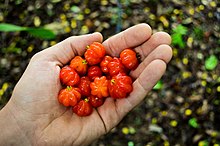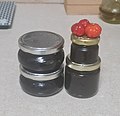Евгения Унифлора
| Суринам Черри | |
|---|---|

| |
| Научная классификация | |
| Королевство: | Plantae |
| Клада : | Трахеофиты |
| Клада : | Покрытосеменные |
| Клада : | Eudicots |
| Clade: | Rosids |
| Order: | Myrtales |
| Family: | Myrtaceae |
| Genus: | Eugenia |
| Species: | E. uniflora
|
| Binomial name | |
| Eugenia uniflora | |
| Synonyms[2] | |
|
List | |
| Nutritional value per 100 g (3.5 oz) | |||
|---|---|---|---|
| Energy | 138 kJ (33 kcal) | ||
7.49 g | |||
0.4 g | |||
0.8 g | |||
| |||
| †Percentages estimated using US recommendations for adults,[3] except for potassium, which is estimated based on expert recommendation from the National Academies.[4] | |||
Евгения Uniflora , Pitanga , [ 5 ] Suriname Cherry , [ 6 ] Бразильская вишня , [ 5 ] Cayenne Cherry , [ 7 ] квадратное вишневое дерево , [ 8 ] Monkimonki Cherry, jangapirí, [ 9 ] или Shimarucu [ 10 ] является цветущим растением в семействе Myrtaceae , родом из Восточного побережья тропической Южной Америки, начиная от Суринам , французская Гвиана до южной Бразилии , а также Уругвай и части Парагвая и Аргентины . [ 8 ] [ 11 ] [ 12 ] Он часто используется в садах в качестве изгороди или экрана. Дерево было введено на Бермудские острова для декоративных целей, но теперь вышло из -под контроля и перечислено как инвазивный вид . [ 13 ] Дерево также было представлено во Флориде . [ 14 ]
Описание
[ редактировать ]Евгения Uniflora - это большой кустарник или маленькое дерево с конической формой, медленно растет до 8 метров (26 футов). Когда ушины, раздавлены или разрезаны, листья и ветви имеют острый смолистый аромат, который может вызвать респираторный дискомфорт у восприимчивых людей. Листья без пристанов, яйцевидных, глянцевых и удерживаемых в противоположных парах. [ 7 ] Новые листья-это бронзовый, медный или медный розовый цвет, созревая до глубокого глянцевого зеленого, длиной до 4 сантиметров (1,6 дюйма). Зимой листья становятся красными.
Flowers have four white petals and are borne on long slender stalks, with a conspicuous central cluster of white stamens ending in yellow anthers. Flowers develop into ribbed fruits 2 to 4 centimetres (0.79 to 1.57 in) long, starting as green, then ranging through orange, scarlet, and maroon as they ripen. Because fruit-eating birds distribute the seeds, they can become a weed in suitable tropical and sub-tropical habitats, displacing native flora.[7]
Uses
[edit]Culinary uses
[edit]The edible fruit is a botanical berry. The taste ranges from sweet to sour, depending on the cultivar and level of ripeness (the darker red to black range is quite sweet, while the green to orange range is strikingly tart). Its predominant food use is as a flavoring and base for jams and jellies.[15] The fruit is high in vitamin C and a source of provitamin A.
The leaves are also used for tea in certain parts of Uruguay.[citation needed]
Use as an insect repellent
[edit]The leaves are spread on some house floors in Brazil so that they exude a smell that repels flies when crushed underfoot.[citation needed]
Medical uses
[edit]Eugenia uniflora has several significant pharmacological properties.[16] Its essential oil is antihypertensive,[16][17] antidiabetic,[18] antitumor[19] and analgesic,[20] and it has shown antiviral and antifungal activity.[21] It has performed against microorganisms such as Trichomonas gallinae (in vitro),[22] Trypanosoma cruzi[23] and Leishmania amazonensis.[16][24]
Gallery
[edit]-
flowers
-
Eugenia uniflora fruits
-
Eugenia uniflora
-
Eugenia uniflora
-
Eugenia uniflora
-
Eugenia uniflora -young leaves
-
With fruits on tree
-
Pitanga jam
References
[edit]- ^ Macdonald, F.; Canteiro, C. (2021). "Eugenia uniflora". The IUCN Red List of Threatened Species. 2021: e.T60330325A60330335. doi:10.2305/IUCN.UK.2021-1.RLTS.T60330325A60330335.en. S2CID 243497699.
- ^ "The Plant List: A Working List of All Plant Species". Retrieved January 28, 2019.
- ^ United States Food and Drug Administration (2024). "Daily Value on the Nutrition and Supplement Facts Labels". FDA. Archived from the original on 2024-03-27. Retrieved 2024-03-28.
- ^ National Academies of Sciences, Engineering, and Medicine; Health and Medicine Division; Food and Nutrition Board; Committee to Review the Dietary Reference Intakes for Sodium and Potassium (2019). Oria, Maria; Harrison, Meghan; Stallings, Virginia A. (eds.). Dietary Reference Intakes for Sodium and Potassium. The National Academies Collection: Reports funded by National Institutes of Health. Washington, DC: National Academies Press (US). ISBN 978-0-309-48834-1. PMID 30844154. Archived from the original on 2024-05-09. Retrieved 2024-06-21.
- ^ Jump up to: a b Nascimento e Santos, Débora; Lima de Souza, Larissa; Nilson José Ferreira; Lopes de Oliveira, Alessandra (2015). "Study of supercritical extraction from Brazilian cherry seeds (Eugenia uniflora L.) with bioactive compounds". Food and Bioproducts Processing. 94. Elsevier: 365–374. doi:10.1016/j.fbp.2014.04.005.
- ^ Setzer, Kenneth (May 12, 2018). "Yes, the Surinam cherry is edible, but that doesn't mean you're going to like it". Miami Herald. Retrieved January 28, 2019.
- ^ Jump up to: a b c "Weeds of Australia: Eugenia uniflora". Queensland Government. Retrieved January 28, 2019.
- ^ Jump up to: a b Duke, James A. (2009). Duke's Handbook of Medicinal Plants of Latin America. p. 309. ISBN 9781420043174.
- ^ "A curious crop". The Honolulu Advertiser. February 28, 2007. Retrieved January 28, 2019.
- ^ Proosdij, A.S.J. van (2012). Arnoldo's Zakflora: Wat in het wild groeit en bloeit op Aruba, Bonaire en Curaçao (in Dutch). Zutphen: Walberg Pers. ISBN 978-9057301629.
- ^ Karp, David (February 7, 2007). "Berry Helped to Put Reality Show Chef on Top". The New York Times. Retrieved January 28, 2019.
- ^ Morton, Julia (1987). "Surinam cherry". Fruits of warm climates. pp. 386–8. ISBN 9780961018412.
- ^ "Bermuda Conservation - Surinam Cherry". Archived from the original on 2012-02-05. Retrieved 2012-05-14.
- ^ "Surinam Cherry: Only Ripe Need Apply". 24 September 2011. Retrieved January 28, 2019.
- ^ Hargreaves, Dorothy; Hargreaves, Bob (1964). Tropical Trees of Hawaii. Kailua, Hawaii: Hargreaves. p. 61. ISBN 9780910690027.
- ^ Jump up to: a b c Lim, TK (2012). "Eugenia Uniflora". Fruits. Edible Medicinal And Non Medicinal Plants. Vol. 3. Springer. pp. 620–9. ISBN 978-9400725348.
- ^ Consolini AE, Baldini OA, Amat AG (1999). "Pharmacological basis for the empirical use of Eugenia uniflora L. (Myrtaceae) as antihypertensive". Journal of Ethnopharmacology. 66 (1): 33–9. doi:10.1016/s0378-8741(98)00194-9. PMID 10432205.
- ^ Matsumura, T; Kasai, M; Hayashi, T; Arisawa, M; Momose, Y; Arai, I; Amagaya, S; Komatsu, Y (2000). "a-glucosidase Inhibitors From Paraguayan Natural Medicine, Nangapiry, The Leaves Of Eugenia Uniflora". Pharmaceutical Biology. 38 (4): 302–7. doi:10.1076/1388-0209(200009)3841-AFT302. PMID 21214481. S2CID 21363070.
- ^ Ogunwande IA, Olawore NO, Ekundayo O, Walker TM, Schmidt JM, Setzer WN (2005). "Studies on the essential oils composition, antibacterial and cytotoxicity of Eugenia uniflora L.". International Journal of Aromatherapy. 15 (3): 147–152. doi:10.1016/j.ijat.2005.07.004.
- ^ Amorim AC, Lima CK, Hovell AM, Miranda AL, Rezende CM (2009). "Antinociceptive and hypothermic evaluation of the leaf essential oil and isolated terpenoids from Eugenia uniflora L. (Brazilian Pitanga)". Phytomedicine. 16 (10): 923–8. doi:10.1016/j.phymed.2009.03.009. PMID 19423309.
- ^ Costa DP, Filho EG, Silva LM, et al. (2010). "Influence of fruit biotypes on the chemical composition and antifungal activity of the essential oils of Eugenia uniflora leaves" (PDF). Journal of the Brazilian Chemical Society. 21 (5): 851–8. doi:10.1590/s0103-50532010000500012.
- ^ Ibikunle GF, Adebajo AC, Famuyiwa FG, Aladesanmi AJ, Adewunmi CO (2011). "In-vitro evaluation of anti-trichomonal activities of Eugenia uniflora leaf". Afr J Tradit Complement Altern Med. 8 (2): 170–6. PMC 3252693. PMID 22238499.
- ^ Santos KK, Matias EF, Tintino SR, Souza CE, Braga MF, Guedes GM, Rolón M, Vega C, de Arias AR, Costa JG, Menezes IR, Coutinho HD (2012). "Anti-Trypanosoma cruzi and cytotoxic activities of Eugenia uniflora L." Exp. Parasitol. 131 (1): 130–2. doi:10.1016/j.exppara.2012.02.019. PMID 22426246.
- ^ Rodrigues KA, Amorim LV, de Oliveira JM, Dias CN, Moraes DF, Andrade EH, Maia JG, Carneiro SM, Carvalho FA (2013). "Eugenia uniflora L. Essential Oil as a Potential Anti-Leishmania Agent: Effects on Leishmania amazonensis and Possible Mechanisms of Action". Evidence-Based Complementary and Alternative Medicine. 2013: 279726. doi:10.1155/2013/279726. PMC 3590759. PMID 23533469.
External links
[edit]- Purdue University New Crop Resource Online Program
- Eugenia uniflora in the Global Invasive Species Database Archived 2013-02-27 at the Wayback Machine
- Eugenia uniflora information from the Pacific Island Ecosystems at Risk project (PIER)
- Оценка риска сорняков для Евгении Uniflora для Гавайев/Тихоокеанского региона Получено 2010-06-20.
- Бермудские службы по охране природы, страница инвазивных видов для Suriname Cherry.








